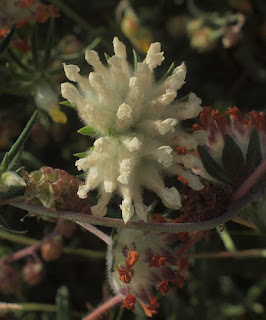In the past Canons Farm has been the subject of this infrequent blog on a number of occasions, I have a particular aversion to the agricutural concrete as on the left, that results from the farming techniques used most of the time.
For the past two years, two fields close to Banstead have not been cultivated (in previous years they seemed to have a problem eliminating Hogweed in crops) and last year saw an explosion of mostly common arable weeds (see Steve Gales post).

I was expecting all through the year for it to be sprayed but no, everything was allowed to seed and growth of wild flowers has continued into this year!
Unlike last year when the hot weather tended to slow growth, this years rain has changed all that with Hogweed, Burdock, Weld, Poppies and many other species growing en masse making a spectacular picture at the moment, see left.
However, for me the star that has dragged out this post is at the eastern end of the field standing proudly on its own, is a plant of Cotton Thistle, Onopordum acanthium, 2m high and not even flowering yet, impressive. It is not particularly rare but I have not seen it the area for a long time.
I have no idea what is going to happen to these fields but it is worth having a look in case the dreaded spray comes out. Whatever happens hopefully the seed bank will be replenished!























